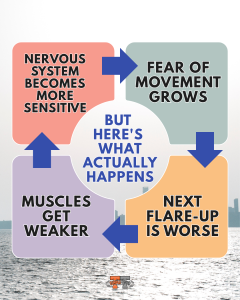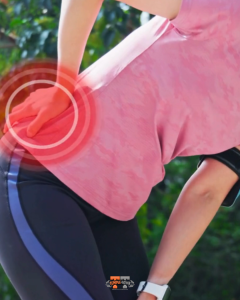The Fear-Flare Cycle: Why Exercise Makes Your Back Pain Worse (And How to Break Free)
Picture this. You wake up Monday morning feeling decent after a weekend that got a bit out of hand at your friend’s barbecue. Your back has been quiet for a few days, so you decide to get back on track with some exercise.
Maybe a gentle gym session. Nothing crazy. Just some light weights and a walk on the treadmill. You warm up properly, use perfect form, and keep everything moderate. You even feel proud of yourself for prioritising your health despite being exhausted from weekend family activities.
Then Tuesday morning arrives. You roll out of bed to get the kids ready and your lower back feels like you’ve been caught by a late tackle in a GAA match. The familiar ache is back, maybe shooting down your leg as you bend to pack lunch boxes.
Your first thought? “I shouldn’t have exercised yesterday. My back just can’t handle it anymore.”
If you’re a busy parent in your thirties or forties, this scenario probably feels painfully relatable. Today we’re exploring the fear-flare cycle and how to break free from the pattern that keeps so many working parents trapped between pain and fear.
What Is the Fear-Flare Cycle?
The fear-flare cycle is one of the most destructive patterns affecting working mothers and fathers dealing with chronic back pain. Here’s how it works:
The more you experience unpredictable flare-ups after trying to exercise, the more you start to fear movement itself. The more you fear movement, the weaker and more sensitive your system becomes, which makes future flare-ups even more likely.
It’s a vicious loop:
- Pain creates fear
- Fear creates inactivity
- Inactivity creates weakness
- Weakness creates more pain

The Science Behind Fear-Avoidance
Research from pain science experts like Lorimer Moseley and David Butler reveals something crucial: chronic pain isn’t just about tissue damage. It’s about a hypersensitive nervous system that starts treating normal activities as threats.
When your brain perceives exercise as dangerous – especially after a few bad experiences – it can trigger protective responses that actually increase pain and muscle tension.
Most busy parents get it wrong by assuming the solution is to avoid activities that seem to trigger flare-ups. This creates what researchers call “fear-avoidance behaviour.”
The result? Reduced activity leads to physical deconditioning. Deconditioning increases vulnerability to injury. This reinforces the fear of movement, completing the destructive cycle.
Studies consistently show that people who remain appropriately active during back pain episodes recover faster and have better long-term outcomes than those who rest completely. However, the activity needs to be graded, progressive, and matched to your current tolerance levels – not the fitness level you had before kids or before your back problems started.
Emma’s Story: From Active Parent to Pain-Controlled Life
Let me share a story that illustrates this cycle perfectly.
Emma came to me after 18 months trapped in this exact pattern. She’d been active her whole life, played football for her local club in her twenties, and stayed reasonably fit even after having children.
Then came her first major flare-up during a particularly stressful period at work while managing a big project from her home office. A simple movement whilst lifting files from her car boot triggered severe spasms that lasted over a week.
“I couldn’t understand it,” she told me. “I’d taken knocks on the football pitch that barely slowed me down. But bending to get my laptop bag from my car destroyed me. I couldn’t even sit properly at my desk for three days.”
The Downward Spiral
After that incident, Emma became hypervigilant about her back. She’d analyse every movement, from lifting her son to reaching for things during her workday. She gradually reduced her activity levels and stopped the weekend hill walks around Slieve Foye that she’d always enjoyed.

Each subsequent flare-up came more frequently despite her caution, reinforcing her belief that her back was fundamentally damaged.
When she contacted me, Emma hadn’t done any proper exercise in over a year. She’d gained weight, felt constantly tired, and was experiencing flare-ups from activities as simple as sitting at her desk all day or carrying shopping bags.
Her back pain had become the filter through which she planned every day.
“I went from someone who could sprint down a football pitch to someone afraid to chase my kids around the garden,” she said. “The weekends used to be for family adventures. Now I spend them on the sofa, exhausted and in pain.”
Breaking the Cycle: The 5-Pillar Solution
The fear-flare cycle doesn’t have to be your reality, even with the demands of family life and career responsibilities. My 5-Pillar System specifically targets this cycle by addressing both the physical and psychological aspects of chronic pain, designed around the realities of busy family life.
Pillar 1: Graded Movement Training
Instead of avoiding exercise or jumping back into old routines, we use progressive loading protocols based on pain science research.
We start with movements that feel completely safe, then gradually build tolerance and confidence in 10-15 minute sessions that fit around work-from-home schedules and family commitments.
For someone like Emma, this meant beginning with bodyweight squats to a high box during her lunch break, then slowly progressing over months to confidently lifting heavy shopping bags and playing actively with her children.
The key is “graded exposure” – systematically increasing activity levels whilst staying within your current capacity. This retrains your nervous system to recognise that movement is safe, not threatening.
Pillar 2: Targeted Mobility Work
We identify and address the specific restrictions that force your lower back to compensate during daily activities like working at a desk all day, lifting children, or weekend household tasks.
Research shows that limited hip and thoracic spine mobility significantly increases lower back stress. By restoring function to these areas first, we reduce the mechanical load on your lumbar spine before progressing to strength training.
Pillar 3: Anti-Inflammatory Nutrition (Real-Life Approach)
Chronic inflammation can sensitise pain pathways and slow tissue healing. But as a busy parent, you also need to live your life – including weekend barbecues, birthday parties, and the occasional night out in Dundalk or Newry.
Studies demonstrate that dietary interventions focusing on omega-3 fatty acids and polyphenol-rich foods can significantly impact pain perception. We implement sustainable changes that account for family meals, weekend socialising, and the reality that you’re not going to eat perfectly all the time.

Pillar 4: Strategic Supplementation
Evidence-based supplements support the physical recovery process:
- Magnesium for muscle tension and better sleep
- Omega-3 fatty acids for inflammation
- Vitamin D – crucial in our Irish climate for bone and muscle health
But supplements are exactly that – supplements to, not replacements for, proper movement and nutrition strategies that fit your budget and lifestyle.
Pillar 5: Stress and Sleep Optimisation
This might be the most crucial pillar for busy parents. Research shows that poor sleep quality and chronic stress directly increase pain sensitivity through neurochemical pathways – both common in working parents juggling home offices and family life.
We implement practical stress management techniques that work during a busy workday and sleep hygiene protocols that account for the reality of family life, unexpected wake-ups, and weekend social activities.
The Transformation Timeline: What to Expect
Within the first month of implementing this approach, clients typically notice their morning stiffness reducing, making those early starts with the kids less painful.
By month two, sleep quality improves dramatically – crucial for parents who need energy for both work and family life.
Month three often brings the first extended pain-free periods in years, meaning they can actually enjoy weekend family activities again.
But the real breakthrough usually comes around month four when a minor flare-up occurs – perhaps after a stressful work deadline or a weekend spent at family events. Instead of catastrophising and retreating to the sofa for two weeks, clients now have tools: gentle movement, stress management techniques, and a new perspective on pain fluctuations.
What used to be two-week setbacks that derailed family plans become two-day inconveniences.
This is when the fundamental shift happens. The pain no longer controls their decisions because they have a proven plan to manage it.
Long-Term Success
In my experience, within six months, clients are typically moving better than before their initial injury. They’ve lost excess weight, regained energy for both work and family life, and most importantly, rediscovered confidence in their bodies.
They still get occasional back twinges – that’s normal for anyone with a history of back pain – but these no longer derail their weekends or family plans.
I regularly receive photos from clients who’ve returned to activities they thought were lost forever: football training sessions, hill walks around the Mournes, family hiking trips to the Cooley Mountains, or simply playing energetically with their children in the garden without fear.
Why This Multidisciplinary Approach Works
What makes this approach effective for busy parents is its foundation in current pain science research combined with practical implementation that fits real life.
We now understand that chronic pain involves complex interactions between physical factors, psychological factors, and social factors – including family stress, work demands, and lifestyle pressures.

Studies show that multidisciplinary approaches produce better long-term outcomes than any single intervention alone. The BackFix system integrates these elements into a practical, progressive programme that working parents can actually follow, even during stressful periods or family crises.
Research also demonstrates the importance of self-efficacy – your belief in your ability to manage your condition whilst maintaining your responsibilities as a parent and professional. Each small success builds confidence, creating a positive feedback loop that reinforces healthy behaviours and reduces fear-avoidance patterns.
The Broader Impact on Family Life
The impact extends beyond just pain relief. When busy parents regain confidence in their bodies, it affects their entire family dynamic.
They’re more present and energetic with their children, more effective at work, and more willing to participate in family activities they’d previously avoided due to pain fears.
I’ve seen former county players return to coaching their local clubs, parents who can properly engage in school sports days again, and working parents who no longer plan their days around managing back pain.
Children notice when their parents are moving freely and participating fully in family life again.
Common Misconceptions About Exercise and Back Pain
“Rest Is Best”
Total rest often makes the fear-flare cycle worse by leading to deconditioning and increased sensitivity.
“No Pain, No Gain”
With back pain, this mentality is counterproductive. The goal is building tolerance gradually, not pushing through pain.
“I Need to Get Back to My Old Routine”
Your body may need a different approach now. That’s not failure – it’s adaptation.
“It’s All Physical” or “It’s All Mental”
Back pain is biopsychosocial. The most effective approaches address physical, psychological, and social factors together.
🚩Red Flags: When to Seek Immediate Help
Stop activity and consult a healthcare professional if you experience:
- Loss of bowel or bladder control
- Sudden severe weakness in your legs
- Pain that shoots down your leg with numbness
- Severe pain that doesn’t improve with rest
Remember, fear-avoidance and appropriate caution are different things.
Practical Steps to Start Breaking the Cycle Today
- Track Your Patterns: Notice what triggers flare-ups beyond just physical activity. Stress, sleep, and emotional factors often play a role.
- Start Small: Choose one gentle movement you can do pain-free and do it consistently.
- Challenge Catastrophic Thinking: When pain flares, avoid thoughts like “I’ve damaged myself” or “I’ll never get better.”
- Gradual Exposure: Slowly reintroduce activities you’ve been avoiding, starting with modified versions.
- Address Sleep and Stress: Poor sleep and chronic stress directly increase pain sensitivity.
Building Long-Term Resilience
The goal isn’t to never experience back pain again – that’s unrealistic for most people with a history of back problems. The goal is to build resilience so that when pain does occur, it doesn’t derail your life.
This means:
- Having movement strategies that work during flare-ups
- Understanding that temporary increases in pain don’t mean permanent damage
- Maintaining physical capacity through consistent, appropriate activity
- Managing stress and sleep as part of your overall health strategy

Moving Forward: Your Next Steps
If you recognise yourself in Emma’s story or the fear-flare cycle pattern, know that you’re not broken. Your back isn’t fundamentally flawed. You just need a system that matches what your body actually needs to function well in daily life.
The fear-flare cycle doesn’t have to be your reality. With the right approach, backed by current research and tailored to the specific challenges of working parents, it’s possible to break free.
The key is understanding that back pain recovery for busy parents isn’t just about fixing what’s wrong – it’s about building resilience, confidence, and practical tools that work even during your most stressful weeks.

Episode 11: The Fear-Flare Cycle – Why Exercise Makes Your Back Pain Worse (And How to Break Free)
Ready for a Complete Solution?
If this approach makes sense but you need a comprehensive, personalised plan, that’s exactly what my BackFix Coaching programme provides.
My 5-Pillar System is designed specifically for working parents in their thirties, forties, and fifties who want to train with confidence, build real strength, and stop the fear-flare cycle once and for all.
This isn’t for everyone. I work with committed individuals who are ready to invest in long-term solutions rather than quick fixes.
If you’re ready to break this cycle and reclaim your confidence, email me at info@templetownsc.com or DM me STRONG on Instagram @TempletownStrengthConditioning.
You deserve more than just getting through your days. You deserve to thrive as both a parent and an individual, with the energy and confidence to fully engage in the life you’ve worked so hard to create.

